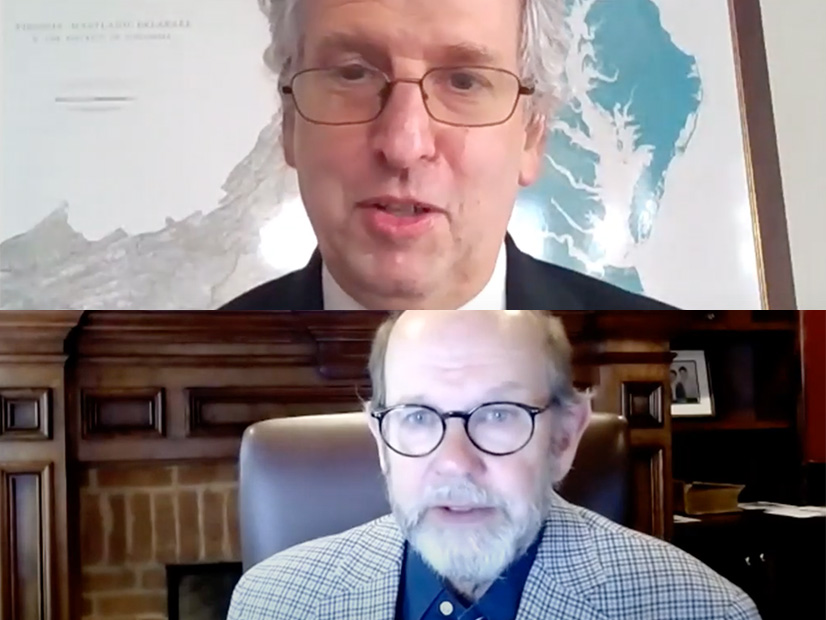The West needs to build transmission lines to connect renewable resources to load if it hopes to successfully make the switch from fossil fuels to wind and solar while maintaining resource adequacy and reliability, FERC Chairman Richard Glick and NERC CEO James Robb said Friday.
Glick and Robb addressed a one-hour session of the Committee on Regional Electric Power Cooperation (CREPC) and the Western Interconnection Regional Advisory Body (WIRAB), the first in this year’s series of CREPC-WIRAB Spring webinars.
FERC commissioners spent significant time discussing transmission and renewable resources at Thursday’s open meeting, Glick said.
“There’s certainly a lot of focus on the issue, primarily as the demand for cleaner renewable resources grows,” he said. “I think folks recognize that in many cases we need to build out the transmission grid to access what are often remotely located renewable resources. We have great resources in the West, both wind and solar, and sometimes those resources are located far from load, and so we certainly need to build out the grid.”
“FERC has a significant role to play” in the process, including in interregional planning and allocating the costs of transmission upgrades, he said.
“I don’t necessarily know whether our current approach to Order 1000 through the interregional planning processes and cost-allocation processes … is sufficient,” Glick said. “We’re actually going to be taking a very hard look at that over the next several months to determine whether we need to move forward with some sort of either modification of Order 1000 or some sort of other approach that would improve planning.”
FERC Order 1000, issued in 2011, was meant to reform transmission planning and cost allocation and to promote competition, but it has disappointed many with its results. (See WIRES Conference Talks Order 1000, Tx Incentives.)
Another area that needs to be addressed is the interconnection process for generators, Glick said.
“Certainly, the queues are longer and longer by the day [and] there’s growing frustration,” he said. “There’s an issue about allocating costs for network upgrades and whether the approach … that’s currently used [in many regions] is sufficient to encourage new development.
“[We] also need to figure out a way to provide a more-fair element,” he said. “For instance, if you are a generating facility and you end up having to pay for a network upgrade, and then three other generating facilities behind you don’t have to pay for it … it’s not necessarily fair and not necessarily conducive to the first generating facility being willing to pay for that upgrade.”
FERC also intends to examine grid efficiency, including line ratings, he said.
“That’s something the commission’s been taking a look at for a couple of years now, whether it be a dynamic line rating approach or an ambient adjusted approach,” which FERC has proposed, Glick said. “I think that’s something we need to take a more serious look at because we have a responsibility not only to build the grid out but also to make the existing grid more efficient.”
In the question-and-answer period, Glick said it would be helpful for transmission planners to get ahead of anticipated generation development. It is clear, he said, that large wind farms will occupy areas such as Wyoming, so “to address what we know is going to happen … why not build out the grid to that particular area now as opposed to waiting” and doing it piecemeal later?
Glick also recommended the West continue to pursue regionalization to promote resource sharing, including one or more RTOs or a “souped-up” version of CAISO’s Western Energy Imbalance Market.
Advocates say greater regionalization will help funnel solar from the Southwest, hydropower from the Northwest and wind power from Wyoming and New Mexico to areas where it is needed, including the densely urbanized areas of the West Coast. Transmission to move the resources is seen as key. (See West Needs to Add Transmission for Renewables, CEOs Say.)
FERC plans to hold a technical conference on resource adequacy in the Western Interconnection on June 23, Glick said.
NERC CEO’s Remarks
In his comments, Robb, who served as CEO of the Western Electricity Coordinating Council before taking the reins at NERC, said that the transformation of the grid from fossil fuels to variable renewable resources is bringing “rapid changes to an industry that’s not used to rapid changes.”
The West is facing growing resource adequacy issues and needs to plan accordingly and build transmission, Robb said.
“I think this gets to the issue of resource adequacy in the West that I know you’re all worried about, and [Glick] talked about,” Robb said. “I would really encourage you all to pay really close attention to where your resource mix is going and the ability to serve load.”
California, some Rocky Mountain states and parts of the Northwest Power Pool face potential capacity shortfalls going forward, according to recent assessments, he said. (See RA at Risk in NWPP-Central, WECC Finds.)
“It is absolutely clear that we need more transmission to be built. That’s both for resilience purposes as well as to unlock the renewable potential that is so embedded in the thinking about where this industry needs to go,” Robb said. “Geographic diversity around renewable resources has to be a top priority for us to unlock.”
Robb also contended that natural gas remains a vital resource because it is dependable and dispatchable.
“We’re going to need gas, and I really think that gas infrastructure is a very important part of this transition,” to renewables, he said. “I know in many cases, and probably in many areas of the West, gas is a four-letter word. But it is now the critical fuel that keeps the lights on and balances all of these renewable resources.”




